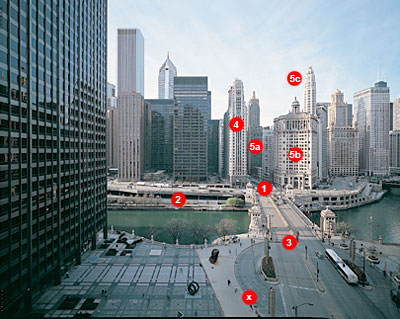 |
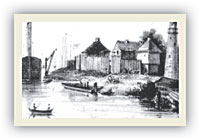 |
1 Captain John Whistler, the grandfather of the painter James McNeill Whistler, designed and built Fort Dearborn here in 1803. Following the massacre of 52 soldiers and settlers, Potawatomi warriors burned the fort on August 15, 1812. Four years later, Capt. Hezekiah Bradley built a second Fort Dearborn, which survived until 1857. |
|
2
After the Civil War, Chicago reigned as the country’s busiest port, and ships carrying lumber, grain, and other commodities clogged the river year round, even anchoring here during the winter months. River traffic abated at the beginning of the 20th century after improvements to the harbor on the Calumet River lured most ships southward. The double-decker Wacker Drive replaced the once teeming wharves-and the Water Street Market-in 1926. |
|
Photo: Brittney Blair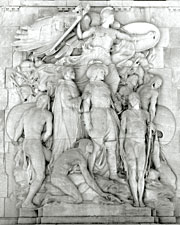 |
3 In 1920, the Michigan Avenue Bridge opened, beginning the transformation of quiet Pine Street into the Magnificent Mile. The two-tiered, double-leaf trunnion bascule bridge is flanked by four 40-foot-tall pylons etched with bas-relief renderings; at the northeast corner, The Discoverers depicts the 1673 arrival of Père Jacques Marquette and Louis Jolliet at the future site of Chicago. |
|
4
Holabird & Root’s 333 North Michigan Avenue Building, shown here a year after its 1928 opening, was influenced by Eliel Saarinen’s second-place submission for the Tribune Tower competition. Some 40 years later, Ludwig Mies van der Rohe designed the Illinois Center complex to the east. |
|
|
5
Trimmed at its summit in gold leaf, today’s Art Deco home to the Hard Rock Hotel opened in 1929 as the Carbide and Carbon Building (5a). Originally known as the London Guarantee & Accident Building (and then as the Stone Container Building), Alfred S. Alschuler’s 360 North Michigan Avenue building (5b) is topped by Corinthian columns and a belvedere. Rising behind it, the 18-story Mather Tower (which sits atop the 24-story 75 East Wacker Drive building) is Chicago’s skinniest skyscraper (5c). |
|
Illustration: John Wiencek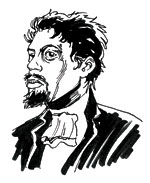 |
X In 1779, the Haitian-born Jean Baptiste Point DuSable built a cabin near what is now Pioneer Court, on the north bank of the Chicago River, becoming the city’s first permanent settler. |
Photography: Nathan Kirkman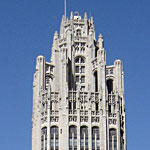 |
Tribune Tower The 36-story, neo-Gothic Tribune Tower was designed in 1925 by John Mead Howells and Raymond M. Hood following an international competition. |


